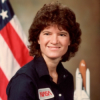Sally Ride

Sally Ride
Sally Kristen Ridewas an American physicist and astronaut. Born in Los Angeles, she joined NASA in 1978 and became the first American woman in space in 1983. She remains the youngest American astronaut to have traveled to space, having done so at the age of 32. After flying twice on the Orbiter Challenger, she left NASA in 1987. She worked for two years at Stanford University's Center for International Security and Arms Control, then at the University of California, San...
NationalityAmerican
ProfessionAstronaut
Date of Birth26 May 1951
CityLos Angeles, CA
CountryUnited States of America
It was hard to become an astronaut. Not anywhere near as much physical training as people imagine, but a lot of mental training, a lot of learning. You have to learn everything there is to know about the Space Shuttle and everything you are going to be doing, and everything you need to know if something goes wrong, and then once you have learned it all, you have to practice, practice, practice, practice, practice, practice, practice until everything is second nature, so it's a very, very difficult training, and it takes years.
There's a huge amount of pressure on every astronaut, because when you get right down to it, the experiments that are conducted on a space flight, or the satellites that are carried up, the work that's to be done, is important and expensive work, and you are up there for a week or two on a Space Shuttle flight. The country has invested a lot of money in you and your training, and the Space Shuttle and everything that's in it, and you have to do things correctly. You can't make a mistake during that week or two that you're in space.
If they asked me if I wanted to go into space tomorrow, I'd do it in a heartbeat. On the other hand, if they asked me if I wanted to go into training for three years and then go into space again, I'd probably say no.
The experience of being in space didn't change my perspective of myself or of the planet or of life. I had no spiritual experience.
The fact that I was going to be the first American woman to go into space carried huge expectations along with it.
When the space shuttle's engines cut off, and you're finally in space, in orbit, weightless... I remember unstrapping from my seat, floating over to the window, and that's when I got my first view of Earth. Just a spectacular view, and a chance to see our planet as a planet.
I slept just floating in the middle of the flight deck, the upper deck of the space shuttle.
The food isn't too bad. It's very different from the food that the astronauts ate in the very early days of the space program.
I do a lot of running and hiking, and I also collect stamps - space stamps and Olympics stamps.
But even in elementary school and junior high, I was very interested in space and in the space program.
It takes a few years to prepare for a space mission.
After the Challenger accident, NASA put in a lot of time to improve the safety of the space shuttle to fix the things that had gone wrong.
On a standard space shuttle crew, two of the astronauts have a test pilot background - the commander and the pilot.
No, I think most astronauts recognize that the space shuttle program is very high-risk, and are prepared for accidents.